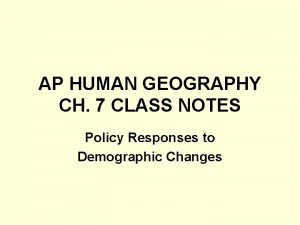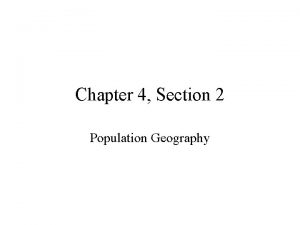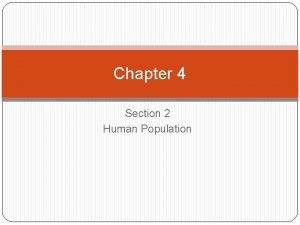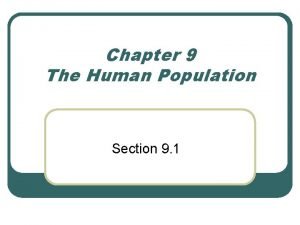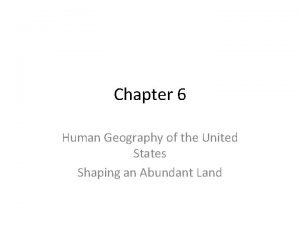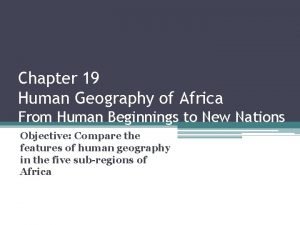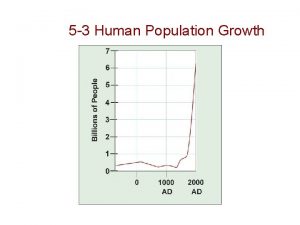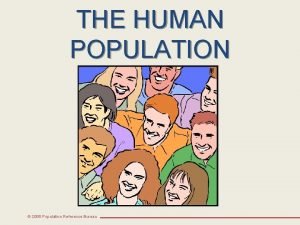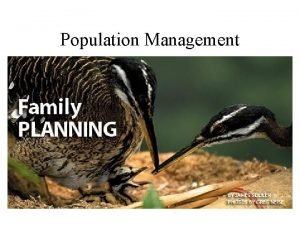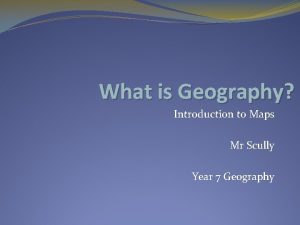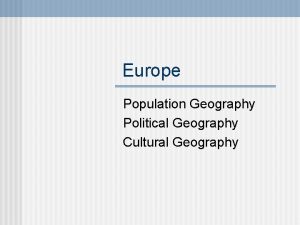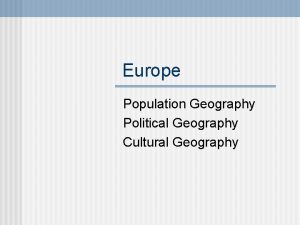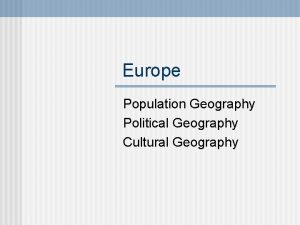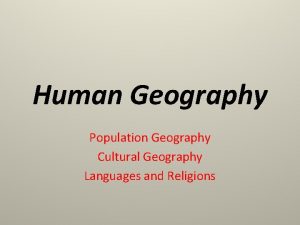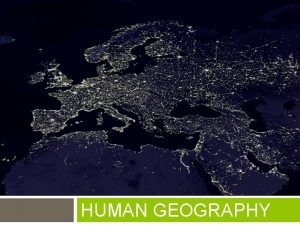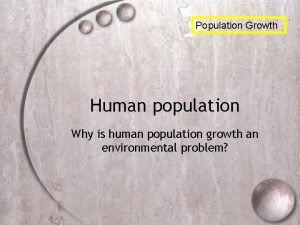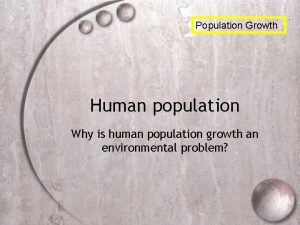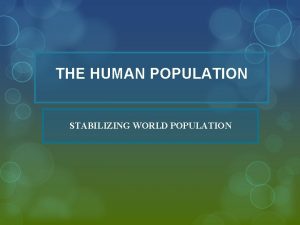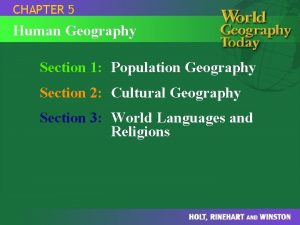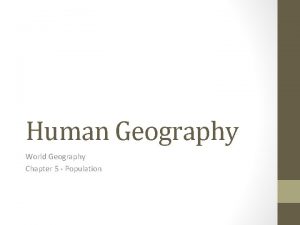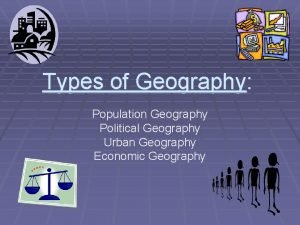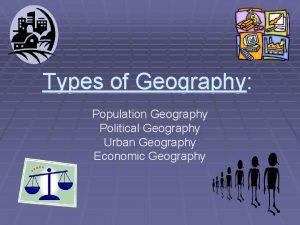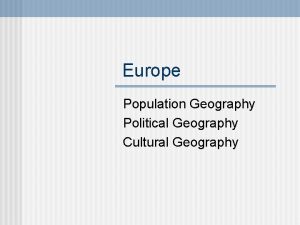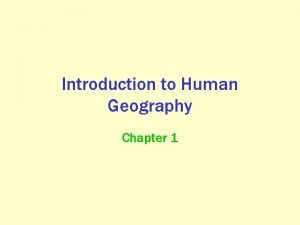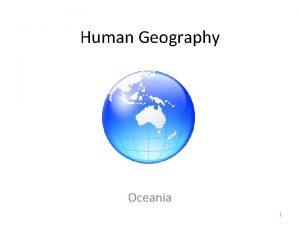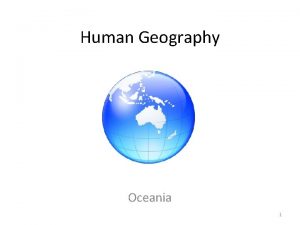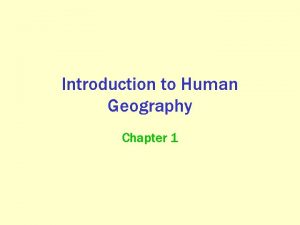Human Geography Population Movements Chapter 3 Population Movements

































- Slides: 33

Human Geography Population Movements Chapter 3

Population Movements Push & Pull factors: Push factors such as unemployment, poverty, hunger and violence push people into migrating. l Pull factors such as relatives and friends abroad, better economic opportunities, a desire to see the world, employment also cause people to migrate. l Barriers to migration: l Quotas l Visas l

Population Movement Chapter 3 - Donor Country - the country from which a person migrates - Recipient Country – the country that receives inward migrants (also called host or receiver) - In the EU, in recent times, countries such as Germany, the Netherlands, Ireland Britain have been recipient/host countries while some eastern European countries have been donor countries.

1. Donor Countries – Advantages of Outward Migration - 1. Reduction in the unemployment rate: - 2. Migrants learn new skills abroad: - 3. Remittances:

Population Movement Chapter 3 Migration Patterns world trends:

Population Movement Chapter 3 Explain the message of the picture:

Population Movement Chapter 3

Population Movement Chapter 3

Population Movement Chapter 3

Remittances Flows to Mexico

2. Donor Countries – The disadvantages of outward migration l 1. The brain drain: l Most young migrants who leave are young and are often among the brightest and talented. They are well educated and the state’s cost of this is lost when they leave. l Outward migration in Ireland increased in 2009 due to economic downturn. Many young construction workers, doctors etc. emigrated to places like New Zealand, Australia and Canada.

3. Recipient Countries – The advantages of inward migration 1. Skills enrichment: l Inward migrants bring skills with them such as entrepreneurial skills and a foreign language. For example google require a large number of people who are skilled in a foreign language. l 2. Cultural enrichment: l Large groups of emigrants bring their culture with them eg foods, music etc. l

3. Recipient Countries – The advantages of inward migration l There is a large Brazilian community in the town of Gort in Co Galway.

4. Host Countries – The disadvantages of inward migration l l l 1. The downward trend in wages: Many inward migrants may be prepared to work for less than local people especially in unskilled jobs and where rent accommodation is cheaper. This drives down the cost of labour and in return the wages of the host population. 2. The Challenge of the language barrier Major barrier to integration. Children at school are at a disadvantage where they have to learn all subjects through the local language. Language teachers are needed to help teachers which is an extra cost to the state. 3. The challenge of integration.

4. Host Countries – The disadvantages of inward migration 3. The challenge of integration: l When migrants from the same country settle in the same urban centre, they tend to congregate among their won people – this trend has led to the emergence of ghettos. l In some countries, distrust & prejudice can grow against inward migrant among the host community. l This can lead to tension and violence. l Racism and xenophobia exist to some degree in many European countries. l

4. Host Countries – The disadvantages of inward migration Netherlands, Belgium and Britain are some European countries that have experienced tensions. l Below is the London riots in summer 2011 l

Asylum Seekers Asylum seekers are allowed enter Ireland to seek refugee status. l While their application is being processed they are entitled to accommodation, health care, a weekly allowance and education for their children. l They may not engage in work whole their application is being processed. l

Refugee applications in Ireland l After the Good Friday Agreement of 1998, any child born in Ireland automatically became a citizen of the Irish state. l In 2004, the Irish people voted in a referendum by a majority of 79% to withdraw the automatic right to citizenship to children born in Ireland of parents who were not of EU citizens.

Migration Policy in the Republic of Ireland l Work permits for inward migrants: l 1. The Green card scheme l 2. Work permits l l 3. Intra-company transfer permits l 4. spousal/dependent permits

Migration Policy in the Republic of Ireland 1. The Green card scheme: l Available to workers with high skills in certain areas such as IT. It is available to workers who will earn salaries in excess of € 60, 000. l 2. Work permits: l Are given to workers earning between 30, 000 and 60, 000 Euro. l

Migration Policy in the Republic of Ireland 3. Intra-company transfer permit: Provided to senior staff of MNCs who are transferred to Ireland. 4. Spousal/dependant work permits: Are available to husbands, wives and children of migrants who already hold work permits

EU Policy on inward migration Inward migration is necessary due to the EU’s ageing population. - Multinational companies need to transfer workers from outside the EU to their EU operations. - Until recently, EU countries have recruited workers separately in non-EU countries. Different countries have different entry requirement that are difficult for would-be migrants to understand. - - Google European headquarters is in Dublin

The EU Blue Card The EU blue card is like the US Green Card. - The card gives work and residence cards to non-EU workers. - To qualify, an inward migrant must be offered a salary 1. 5 times the average salary of the EU country. - The blue card came into operation in 2011. -

An EU Policy on Asylum Seekers - - The Dublin System (named after a meeting in Dublin in 2003): Under this system the EU country that the refugees first enter has to deal with their asylum application. An application by an asylum seeker can be examined by only one member state and this often means sending migrants within the EU back to their point of entry. When introduced in 2003, illegal immigrants entering Germany and northern Europe declined. Migrants were sent back to their entry points so there was greater pressure put on Spain, Italy and Greece – entry points in the Mediterranean.

An EU Policy on Asylum Seekers

Ethnic, Racial and Religious issues that arise from Migration The issues above can often arise between the host country and the migrants. - There are now many multicultural societies and intercultural societies in Europe - Case study – Hand out: - Read ‘The banning of the niqub in France’. -

Further case Studies/Hand outs – Chapter 3 - 1. Rural to urban migration in the Developed world - Ireland - 2. Rural to urban migration in the Developing world - Brazil

The Banning of the niqab in France – Read case study hand out - In 2010 a controversial law was passed banning Muslim women from wearing a facial veil. Anyone wearing a facial veil was fined € 150 - Anyone (husband or brother etc) who forced a woman to wear a facial veil could be fined up to € 30, 000 and up to a year in prison -

- The impact of rural to urban migration on rural areas: 1. Population decline 2. Decline in services 3. Male/female imbalance The dependency ratio of Co Leitrim in 2011 was 57. 3%. Can you explain that?

- The impact of rural to urban migration on Urban centres: 1. Urban sprawl 2. Traffic Congestion (You can also use notes from chapter 7 – urban growth & problems for your answer) Urban Sprawl is the uncontrolled spread of urban areas into the surrounding countryside. Fact: If Dublin had the same population density per km 2 as Paris, the city would occupy a mere one sixth of its present area.

Rural to urban migration in the developing world - BRAZIL The impact of rural to urban migration has led to shanty towns (favelas) in the large cities of Brazil. There are many push and pull factors in regard to rural to urban migration in Brazil. 85. 2% of Brazil’s population live in cities.

Questions - OL Migration: 1. 1. Describe & explain one positive & one negative effect of people migrating. 2. (i) Explain 2 reasons why people migrate from rural areas to cities. (ii) Explain one effect that this has on the rural areas they have left behind. (iii) Explain one reason why large numbers of Irish people are emigrating from Ireland in recent times. 2. 3. Explain two problems the west of Ireland faces by people migrating to the Dublin region. 4. Describe two problems that can arise from religious or ethnic issues as a result of migration.

Migration: Questions - HL 1. Examine the impact of population movement on donor and receiver countries. 2. With reference to examples you have studied, examine the impacts of rural to urban migration in a developed country. 3. Outline the effects of rural to urban migration in a developing country. 4. ‘Ethnic and religious issues can arise as a result of migration’ - Examine this statement with reference to example(s) you have studied. 5. Examine two major changes in the patterns of Irish
 Baby bust definition ap human geography
Baby bust definition ap human geography Frq examples ap human geography
Frq examples ap human geography 5 themes of geography ap human geography
5 themes of geography ap human geography Stateless nation
Stateless nation Human development index definition ap human geography
Human development index definition ap human geography Which of the following is also known as axial movement
Which of the following is also known as axial movement Population ecology section 1 population dynamics answer key
Population ecology section 1 population dynamics answer key Population ecology chapter 4 answers
Population ecology chapter 4 answers Chapter 4 section 2 population geography
Chapter 4 section 2 population geography Chapter 4 section 2 human population
Chapter 4 section 2 human population Chapter 4 section 1 population dynamics
Chapter 4 section 1 population dynamics Chapter 9 the human population section 1
Chapter 9 the human population section 1 Ap human geography chapter 11 vocab
Ap human geography chapter 11 vocab Chapter 16 ap human geography
Chapter 16 ap human geography Chapter 22 human geography of southwest asia
Chapter 22 human geography of southwest asia Chapter 11 ap human geography
Chapter 11 ap human geography Chapter 7 lesson 2 social studies
Chapter 7 lesson 2 social studies How do languages diffuse ap human
How do languages diffuse ap human Chapter 13 human geography of europe
Chapter 13 human geography of europe Received pronunciation definition ap human geography
Received pronunciation definition ap human geography Why is the united states called a postindustrial economy
Why is the united states called a postindustrial economy Chapter 25 human geography of south asia
Chapter 25 human geography of south asia Chapter 19 section 1 east africa
Chapter 19 section 1 east africa Chapter 8 human needs and human development
Chapter 8 human needs and human development Chapter 8 human needs and human development
Chapter 8 human needs and human development Population ecology section 1 population dynamics answer key
Population ecology section 1 population dynamics answer key Population ecology section 1 population dynamics
Population ecology section 1 population dynamics Whats a density dependent factor
Whats a density dependent factor 5-3 human population growth
5-3 human population growth Human population
Human population Human design blueprint
Human design blueprint Human minimum viable population
Human minimum viable population Brownfields ap human geography
Brownfields ap human geography Topographic map definition ap human geography
Topographic map definition ap human geography
